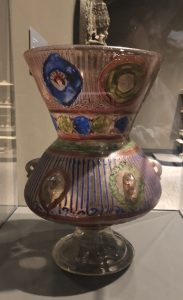
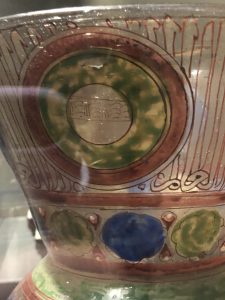
This mosque lamp from an unidentified artist from fifteenth century Syria is made of glass, polychrome enamel, and gold (fig. 1). This religious object is an example of blown glass, which was the primary method of glass-making during this period, with attached details like the six small, handle-like knobs around the bottom and the non-decorated base that allows it to stand up. The most notable details, however, are not in the form of the glass itself but in the enamel and gold decorations that adorn the outside of the piece as decoration. These include only letter and floral-like motifs that recall traditional arabesque decoration due to how the depiction of people and animals is discouraged in traditional Islamic art. According to the “Religion and Ritual Object Guide,” the thin, decorative letters spell “al-‘alim” in thuluth script, which means “the wise.” This represents Allah’s omnipresence and all-knowing nature.
Because the object is a lamp, it would be used as a light in a mosque. It could have been set down as it sits in the museum or hanging, likely attached by the six small handles (see fig. 3). These handles would have been created by either twisting and pulling small sections of the glass up and out while it was being blown or by creating the
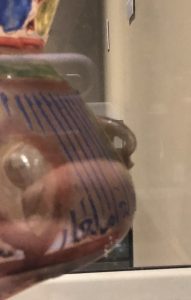
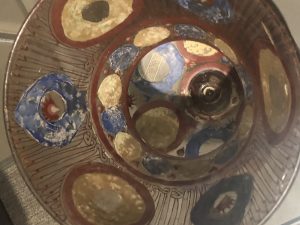
handles by forming it with metal tools while it was hot and then attaching the handles to the main vessel separately. Glass is the best material that could be used for this purpose because it can withstand the heat of the oil or candle that would be placed within the vessel. The lamp’s transparency could also allow light from the fire within to illuminate its surrounding space. The colorful enamel motifs elevate this light to become a sort of divine presence in the holy mosque. In this way, it relates the thuluth script on the exterior because the wise, omnipresent God fills every inch of the mosque’s space in illuminating light, which could also be considered knowledge.
This is similar to the use of glass in Christianity first popularized in the Gothic period of the twelfth century. In Gothic cathedrals, stained glass windows were blown, stained, and arranged to portray a message through the depiction of Christian scenes, similar to how the lamp relays the message of God’s knowledge through its use of script. The heavenly light that shone through the stained-glass windows
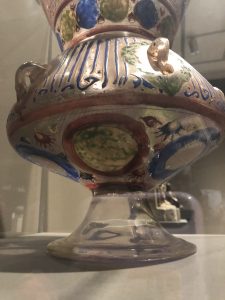
represented the presence of the Christian God, similar to the light of the Islamic lamp. Because of the lamp’s function as a distributor of light, the enamel is bright and light in color. There are very fine lines created by the application of enamel with, likely, a thin brush. This is why the glass of the vessel itself is clear instead of stained; the artist or craftsman wanted the details of his enamel drawing to be very visible so that the script could be read. Other areas look as if the enamel was painted on with a larger brush because it is uneven in thickness and opacity. On the script on the bottom half of the vase, the blue enamel is very thick and looks as if it was applied heavily with a single stroke (fig. 5). This creates a decorative glass object that has both function, beauty, and religious significance. The use of glass contributed to all three of these attributes due to its ability to illuminate a space when filled with light, its decorative enamel motifs, and these motifs’, as well as its function’s, religious meanings about the holy presence and knowledge of God.